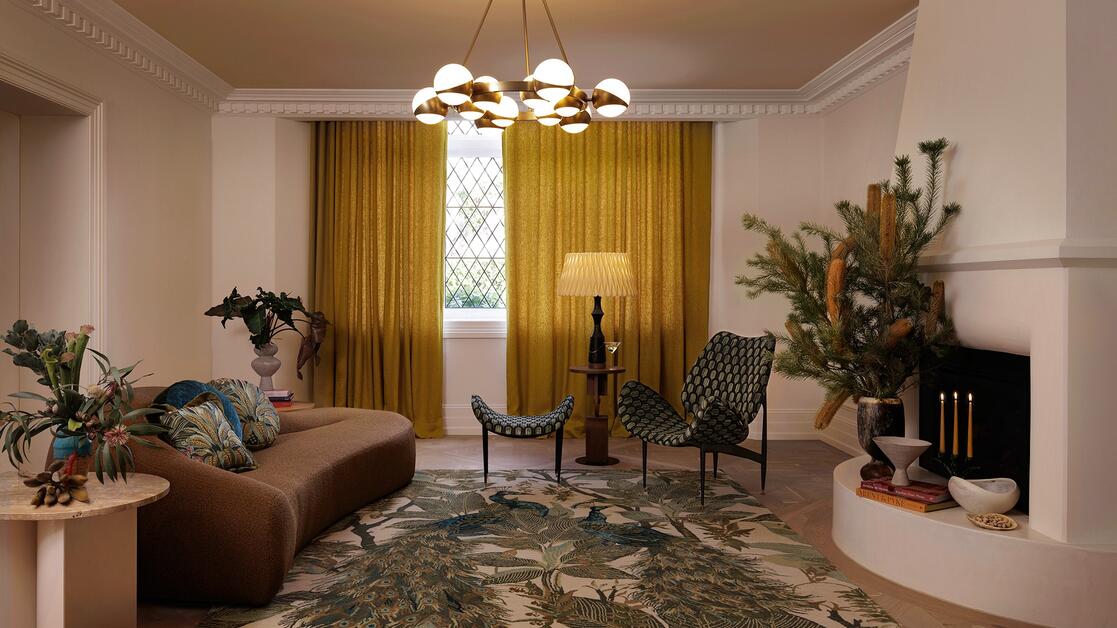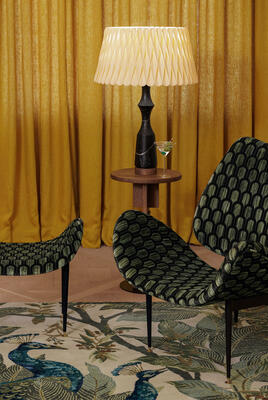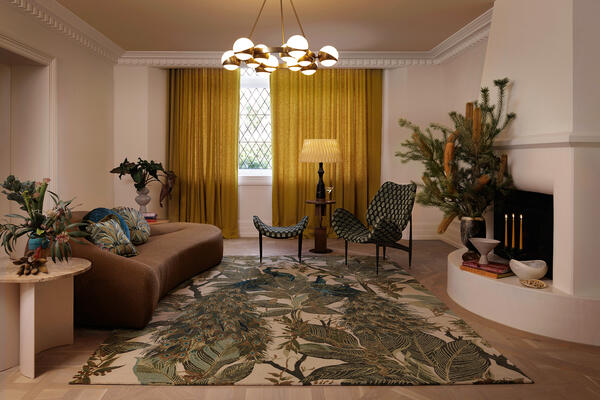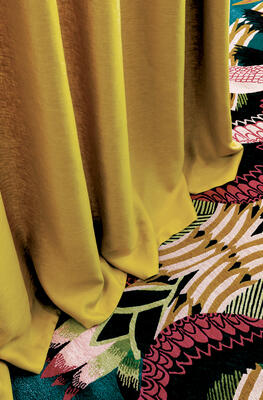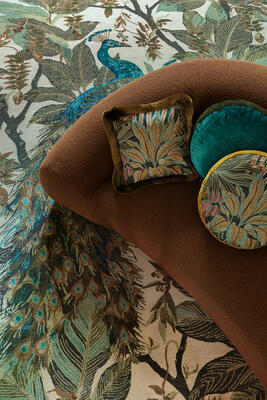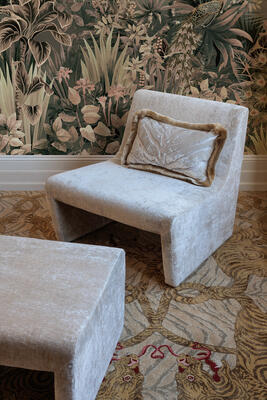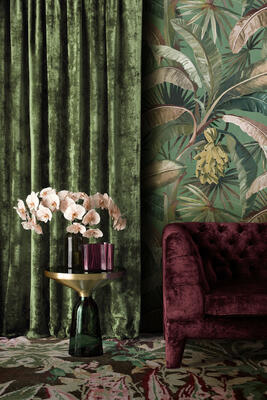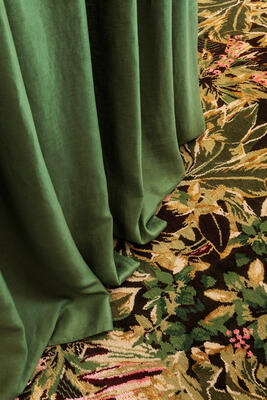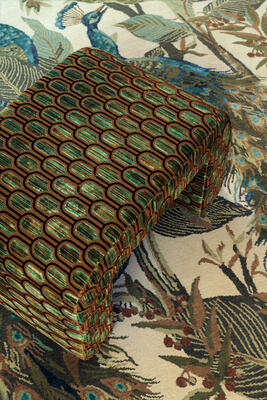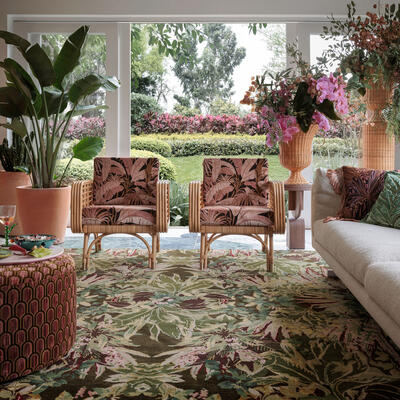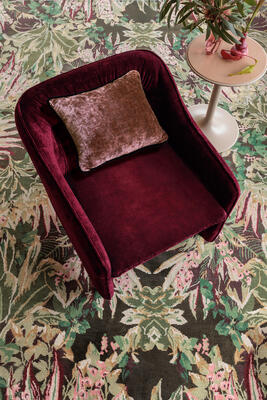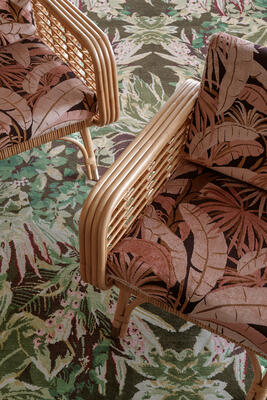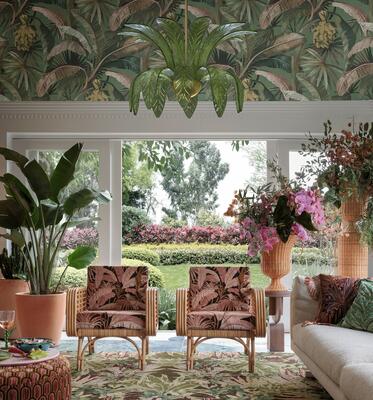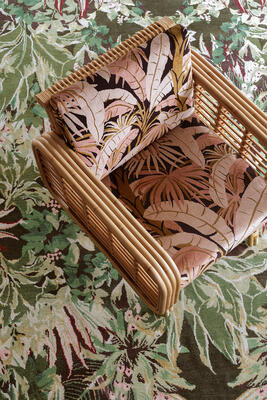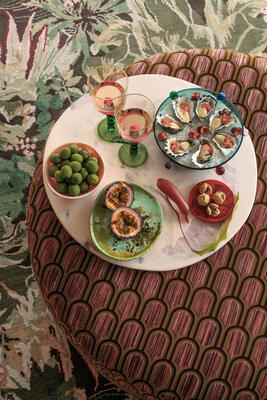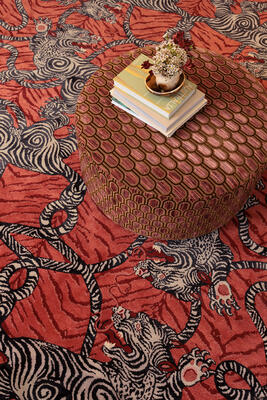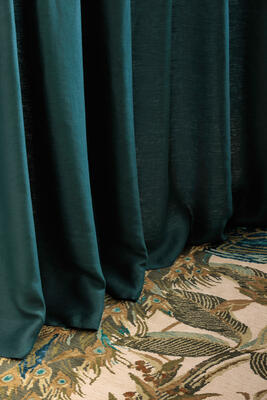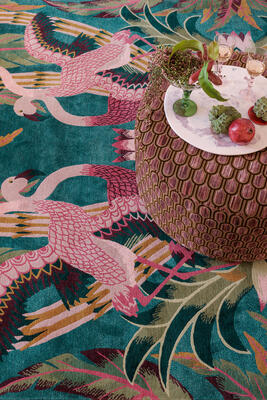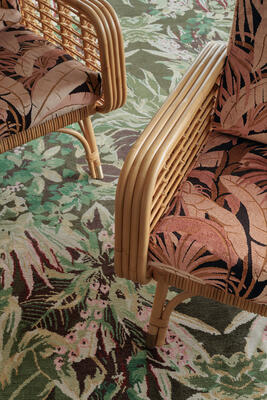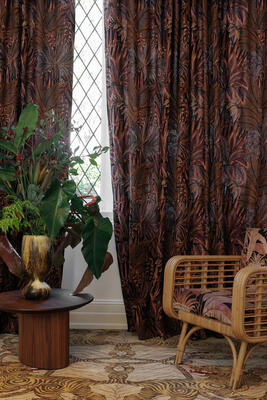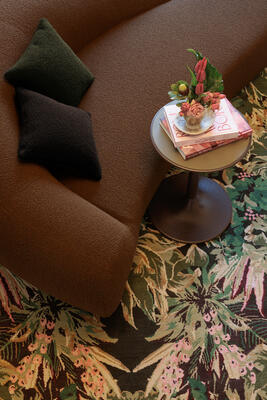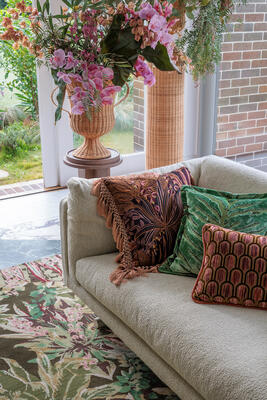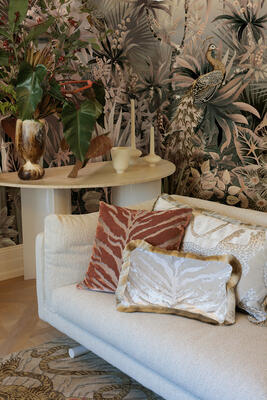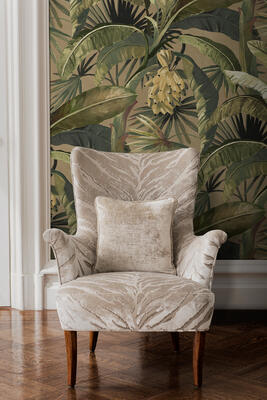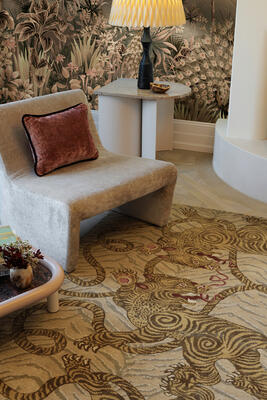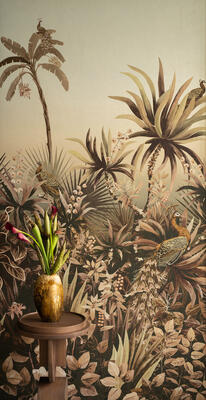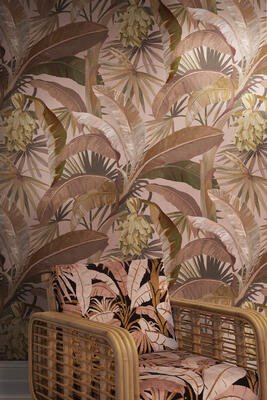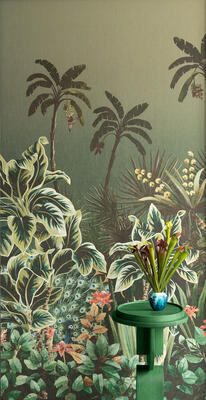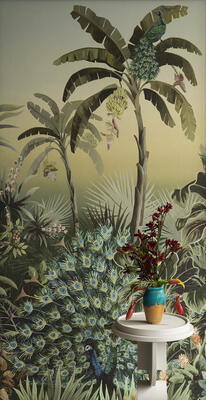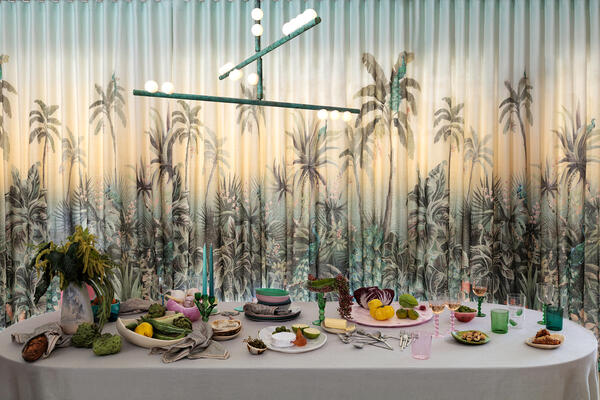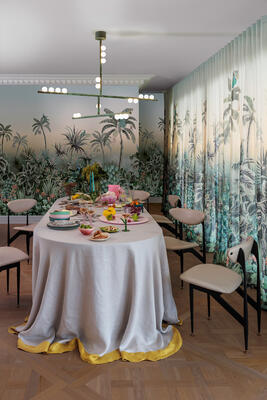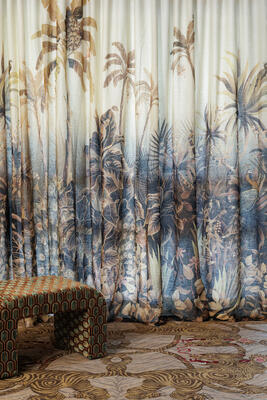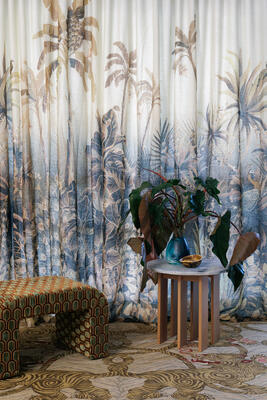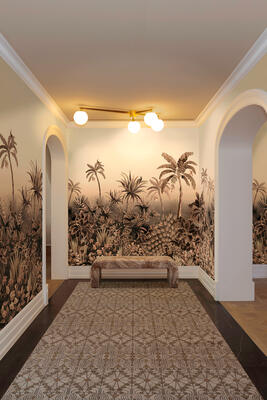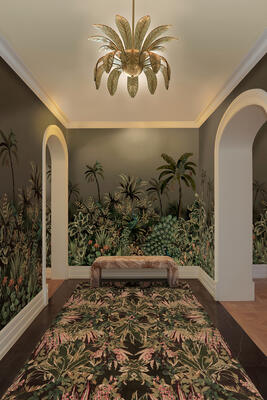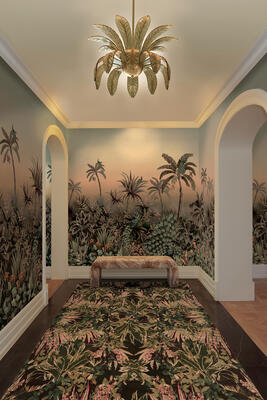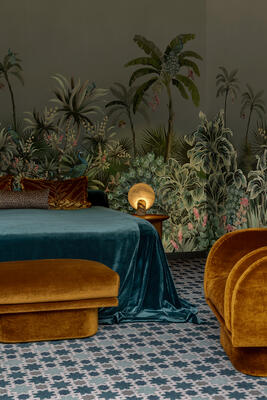What’s the inspiration behind the new collection, Moonlight Memphis?
Martin: I love the combination of texture and pattern because the amalgam creates a visual opulence celebrating my nostalgia for the way fabrics were used in the 1970s. In this period, there was a revival of craft-oriented textiles that had a hand-loomed aspect, as well as a resurgence of dramatic and dynamic patterns. We used this combination in our set decoration for the movie Elvis to underline the singer’s highly decorative personal style, and I wanted to explore this in my own collection. I’m also currently spending a lot of time in Queensland, which is a tropical part of Australia. I’m surrounded by palm trees and lush foliage. This exuberant landscape is enormously inspiring.
How did the relationship between Mokum and Catherine Martin come about?
Moffit: This is Mokum’s sixth collaboration with Catherine. It first started when she approached us out of the blue! She had just released a line of rugs and wallpapers based on her and her husband Baz Luhrmann’s film Australia and was beginning work on The Great Gatsby. She wanted to build on the patterns developed for floors and walls to include textiles, extending her offering as a holistic interiors range.
The initial vision was to design patterns inspired by her film work, in coordination with these rugs and wallpapers. Over the last decade, this approach has evolved: We still very much focus the collections on Catherine’s extensive and exacting research for her film projects; however, we have increased our scope to include plain upholstery and drapery textiles, creating a comprehensive offering under our collaborative umbrella.
How has collaborating with Catherine Martin elevated or expanded Mokum’s brand image?
Moffit: Catherine’s projects have led to us creating textile installations for Tiffany & Co., providing wallpapers and textiles for an exclusive suite at the Plaza Hotel in New York, and designing custom fabrics for the Faena Hotel in South Beach, Miami. Our fabrics are also featured in The Great Gatsby and Elvis films.
This new collection is described as utilizing a “contemporary reimagining of a 1970s palette.” How do you strike that balance between nostalgic and modern?
Martin: I think when you are inspired by the past but living in the present, you can’t help but see that previous period through a contemporary lens. Whether it’s designing for a film or a Mokum fabric and wallcovering collection, it’s about taking historical inspiration and interpreting it so a contemporary audience can connect to the story you’re trying to tell.
The new velvet constructions, Palm Springs and Beverly Hills, are real statement pieces. Can you describe the process behind designing these luxurious velvets? What story are you trying to tell through them?
Moffit: We wanted to create nostalgic textiles that evoke the feeling of discovering a vintage piece, but with a modern aesthetic. It was poignant that the surface pattern, construction and palette all sat comfortably on contemporary furniture and suited a variety of interior styles.
Palm Springs and Beverly Hills are both jacquard velvets with lustrous viscose pile yarns. We revisited the original La Palma artwork when creating Palm Springs: removing the iconic bananas from our print design and using a combination of loop and cut pile techniques to capture the tropical foliage in viscose and polyester yarns. The peacock feather motif of Beverly Hills is constructed in multihued stria yarns that offer a unique depth of color. Each motif is surrounded by cut velvet and set on top of a fine ottoman-weave background.
You’ve expanded the color palette for pieces like Bespoke Velvet and Grande Boucle. How do the new shades align with the overall 1970s-inspired aesthetic?
Moffit: The palette is tinged with nostalgia: warm neutrals, gold, bronze, rust, whisky and rich chocolate tones that speak to the 1970s influence. We also expanded our offering of greens—building on the success of our bestselling Bespoke color Martini, which is a complex dark olive green, by adding tropical palm greens, darker forest hues and a bold oxide green.
The Jungle Room embroidery features motifs from the Royal Menagerie collection. Why did you decide to revisit and adapt them? And how does the new Muscat colorway add to the story?
Moffit: We were thrilled with the response to Jungle Room. We hadn’t designed an embroidery for a long time, and it was a risk, as it is such a decorative product. But it’s been exceptional. As Whisky became the hero color story of the collection, we knew we wanted to add this shade to Jungle Room, eventually settling on the dark and decadent Muscat variation. We included a matching colorway in Satnin, so it works beautifully alongside the drapery. And against this wonderfully complex stitching, you’ll find a little pop of chartreuse giving it a lift.
What inspired the name Satnin for the new linen drapery? And how does this fabric balance timeless elegance with a contemporary aesthetic?
Moffit: Catherine suggested Satnin, Elvis’s nickname for his mother, as the name for our new linen drapery. We wanted to expand our drapery offering with a subtle hint of glamour; however, we sought an informal substrate to suit the core values of our brand.
When we speak about luxury in our market, it must be livable and approachable. Satnin brings exactly that touch of relaxed glamour. The natural luminosity of the linen yarn is accentuated by the satin weave, while the textured slub yarn retains the sense of approachability. Because it’s piece-dyed, we were able to develop a custom color palette. Satnin champions our commitment to injecting more optimistic, playful colors into the range—it’s a basic that’s not basic at all.
Nightbird Symphony brings together painted motifs from your past collections. What was the process of curating and combining these motifs into a new design?
Moffit: It was an enormous undertaking due to its scale and being both hand-painted and digitally printed. The amount of work required to clean and color the art was equivalent to creating six print designs at once. But seeing how the hand-painted details and custom colors are captured in the full-scale printed version is more than worth it.
The motifs are an amalgamation of our past artworks. Repainted to suit new positions and scales, our Nightbird Symphony includes the famous palm trees from La Palma, foliage from Monkey Business, and of course a regal family of birds inspired by Royal Peacock. We are currently working on designs inspired by the new foliage within this print, so watch this space for the next iteration!
What excites you most about this collection? What do you hope people feel when they experience these textiles and designs?
Martin: I think you’re always trying to build on, speak to and interact with your previous collections, because inherently you want to build a body of individual textiles and wallcoverings that can speak to one another and be used in multiple ways in any given environment. I am always conscious that when designing a new collection there is a dialogue with past collections, so that we’re building on a previous aesthetic. I think we live in a very disposable culture. One of the great things about interior design, textiles and wallcoverings is that they have a much longer life cycle. It’s lovely to be able to refresh and enhance a room while not necessarily throwing everything out from the past. I believe combining old and new gives spaces soul.
With this collection, I hope people enjoy the exuberance of the patterns and the sensual textures of the fabrics. It’s all about being playful and joyful.















